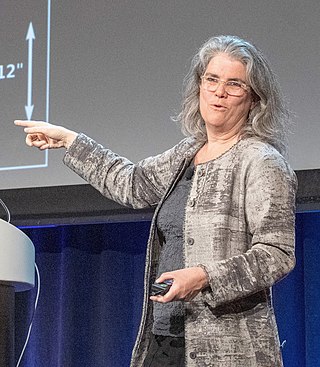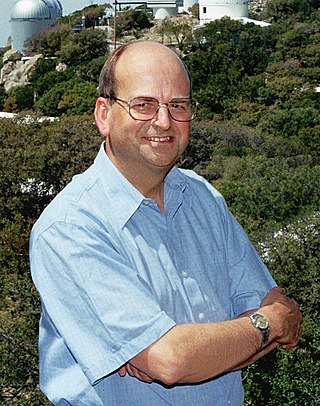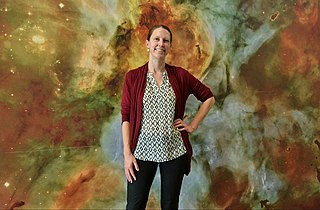Related Research Articles
Marc Aaronson was an American astronomer.

The American Astronomical Society is an American society of professional astronomers and other interested individuals, headquartered in Washington, DC. The primary objective of the AAS is to promote the advancement of astronomy and closely related branches of science, while the secondary purpose includes enhancing astronomy education and providing a political voice for its members through lobbying and grassroots activities. Its current mission is to enhance and share humanity's scientific understanding of the universe as a diverse and inclusive astronomical community.
The Catherine Wolfe Bruce Gold Medal is awarded every year by the Astronomical Society of the Pacific for outstanding lifetime contributions to astronomy. It is named after Catherine Wolfe Bruce, an American patroness of astronomy, and was first awarded in 1898.
The George Van Biesbroeck Prize is an award for long-term achievements in the field of astronomy. According to the American Astronomical Society awards website; "The Van Biesbroeck prize is normally awarded every two years and honors a living individual for long-term extraordinary or unselfish service to astronomy, often beyond the requirements of his or her paid position."

Andrea Mia Ghez is an American astrophysicist and professor in the Department of Physics and Astronomy and the Lauren B. Leichtman & Arthur E. Levine chair in Astrophysics, at the University of California, Los Angeles. Her research focuses on the center of the Milky Way galaxy.

Bryan Malcolm Gaensler is an Australian astronomer based at the University of Toronto. He studies magnetars, supernova remnants, and magnetic fields. In 2014, he was appointed as Director of the Dunlap Institute for Astronomy & Astrophysics at the University of Toronto, after James R. Graham's departure. He is currently the co-chair of the Canadian 2020 Long Range Plan Committee with Pauline Barmby.

Alexei Vladimir "Alex" Filippenko is an American astrophysicist and professor of astronomy at the University of California, Berkeley. Filippenko graduated from Dos Pueblos High School in Goleta, California. He received a Bachelor of Arts in physics from the University of California, Santa Barbara in 1979 and a Ph.D. in astronomy from the California Institute of Technology in 1984, where he was a Hertz Foundation Fellow. He was a postdoctoral Miller Fellow at Berkeley from 1984 to 1986 and was appointed to Berkeley's faculty in 1986. In 1996 and 2005, he a Miller Research Professor, and he is currently a Senior Miller Fellow. His research focuses on supernovae and active galaxies at optical, ultraviolet, and near-infrared wavelengths, as well as on black holes, gamma-ray bursts, and the expansion of the Universe.
Lisa Jennifer Kewley is an Australian Astrophysicist and current Director of the Center for Astrophysics | Harvard & Smithsonian. Previously, Kewley was Director of the ARC Centre of Excellence for All Sky Astrophysics in 3-D and ARC Laureate Fellow at the Australian National University College of Physical and Mathematical Sciences, where she was also a Professor. Specialising in galaxy evolution, she won the Annie Jump Cannon Award in Astronomy in 2005 for her studies of oxygen in galaxies, and the Newton Lacy Pierce Prize in Astronomy in 2008. In 2014 she was elected a fellow of the Australian Academy of Science. In 2020 she received the James Craig Watson Medal. In 2021 she was elected as an international member of the National Academy of Sciences. In 2022 she became the first female director of the Center for Astrophysics | Harvard & Smithsonian.
The Marc Aaronson Memorial Lectureship, also known as the Aaronson Prize, is an award of the University of Arizona Department of Astronomy and Steward Observatory which promotes and recognizes excellence in astronomical research. It is named after astronomer Marc Aaronson, who died in 1987 in an accident while making astronomical observations. He was 36 years old.
James Roger Prior Angel is a British-born American astronomer. He is Regents Professor and Professor of Astronomy and Optical Sciences at the University of Arizona.
Kenneth R. Sembach is an American astronomer and, from October of 2015 to August of 2022, was the Director of the Space Telescope Science Institute in Baltimore, Maryland.
Alan Michael Dressler is an American astronomer at the Carnegie Institution for Science of Washington, D.C. Among his works is the popularization Voyage To The Great Attractor: Exploring Intergalactic Space.

Jeremy Richard Mould is an Australian astronomer currently at the Centre for Astrophysics and Supercomputing at Swinburne University of Technology. Mould was previously Director of the Research School of Astronomy and Astrophysics at the Australian National University and the American National Optical Astronomy Observatory. He is an Honorary Professorial Fellow, at the University of Melbourne.
Don E. Winget is an American astronomer and astrophysicist who studies white dwarf stars. He is the Harlan J. Smith Centennial Professor in Astronomy and a university distinguished teaching professor at the University of Texas at Austin.

Heather A. Knutson is an astrophysicist and professor at California Institute of Technology in the Division of Geological and Planetary Sciences. Her research is focused on the study of exoplanets, their composition and formation. She won the American Astronomical Society's Newton Lacy Pierce Prize in Astronomy for her work in exoplanetary atmospheres.
Kristen Sellgren is an American retired astronomer and Professor Emerita at the College of Natural and Mathematical Sciences, Ohio State University. She won the Newton Lacy Pierce Prize in Astronomy in 1990. She is the founder of American Astronomical Society's Committee for Sexual-Orientation & Gender Minorities in Astronomy (SGMA).
Nadia Zakamska is a Russian-American astronomer who is a professor at Johns Hopkins University.
Harriet Dinerstein is an American astronomer. The American Astronomical Society honored her work by awarding her the Annie J. Cannon Prize in 1985. She also received the Newton Lacy Pierce Prize in 1989. Dinerstein received her Bachelor of Science degree from Yale University in 1975 and her Ph.D. from the University of California, Santa Cruz in 1980. She currently is a Professor of Astronomy at the University of Texas at Austin.

James Moran is an American radio astronomer living in Massachusetts, USA. He was a professor of Astronomy at Harvard University from 1989 through 2016, a senior radio astronomer at the Smithsonian Astrophysical Observatory from 1981 through 2020 and the director of the Submillimeter Array during its construction and early operational phases from 1995 through 2005. In 1998 he was elected to the National Academy of Sciences, in 2010 to the American Academy of Arts and Sciences, and in 2020 to the American Philosophical Society. He is currently the Donald H. Menzel Professor of Astrophysics, Emeritus, at Harvard University.
References
- ↑ "Newton Lacy Pierce Prize in Astronomy". American Astronomical Society. Archived from the original on 2013-02-11. Retrieved 2008-04-02.